Two Properties Reveal Middleburg Legacies

An In Depth Look at the History Behind the Houses
Story by Heidi Baumstark
Ownership becomes part of one’s legacy. While uncovering stories of two Middleburg properties, their owners leave a rich legacy peppered with historical treasures.
Sotheby’s International Realty in downtown Middleburg is the listing agency for two historic properties: Middleburg House dating to 1790 and Stonyhurst, built a century later, Middleburg House was built just a few years after the 1787 establishment of Middleburg and sits in the center of town on 105 S. Madison Street, which is part of the Middleburg Historic District that includes 18th-century structures with most dating to the mid-19th century. This property has strings to the family of Leven Powell, founder of Middleburg, who fought with George Washington during the American Revolution.
The Stonyhurst estate (originally called Mount Olive) is just shy of 95 acres, only a mile from town on winding Foxcroft Road where hunters and riders have galloped for centuries; today, Middleburg is known as the nation’s fox hunting capital. Its original owner, Edward Samuel Duffey, fought in the Civil War, reportedly firing the last shot at Gettysburg.
Gail Reardon is the listing agent for Middleburg House and Peter Leonard-Morgan is the agent for Stonyhurst. Reardon shared information about Middleburg House noting that the oldest part started with a log room with one floor above. The earliest sections include thick, sturdy walls that are 2-plus-feet deep with thick-beamed ceilings in the front rooms. Large, original fireplaces are in five rooms. The lower level has an original “tap” room with a separate kitchen and bath. Updates include a spacious kitchen and dining room, plus French windows overlooking a private, landscaped back yard. Clearly, it is one of the unique historical residences within easy walking distance to shops and restaurants in town.

What about its legacy? According to Laura Christiansen, curator of manuscripts and archives at Thomas Balch Library in Leesburg, the property is included in John Lewis’ 1977 architectural survey of Middleburg as property number 259-110, and is described as a “Two story stuccoed and pained four bay Town House, with hipped roof and four part front porch with Roman Doric Columns, on high basement. Good lattice work under porch. Unusually large exterior chimneys on both gable ends. Circa 1800’s or earlier.”
The 1982 National Register of Historic Places (NRHP) inventory nomination form for the Middleburg Historic District also states that property “259-110” is a “Two-and-a-half-story stucco town house, with hipped roof and four-bay front porch with Roman Doric columns. Unusually large exterior chimneys on both gable ends. Early 19th century.” Who lived here? Christiansen’s research uncovered Wynne Saffer’s maps of Loudoun prepared from the 1860 tax maps. The east side of S. Madison Street is shown as being acquired in 1853 by M.F. Powell. The tax record lists “Marietta F. Powell” (Marietta Fauntleroy Turner Powell, 1812-1894) and references a deed for “243.75” acres. The drawn map outlines this area of her property that includes the S. Madison Street section and extends to what was Burr Powell’s Hill Farm on the south edge of Middleburg. Burr Powell (1768-1839) was the father of Marietta’s late husband, George Cuthbert Powell (1807-1849), who died at the age of 41. Burr Powell (son of Middleburg founder, Leven Powell) served in the Virginia General Assembly from 1798 to 1807. He was a state senator from Loudoun and Fauquier counties from 1813 to 1815 and practiced law in Middleburg.
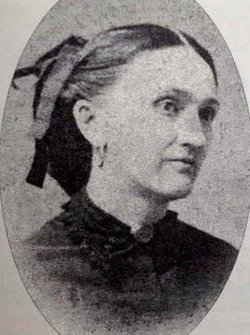
Christiansen also found a copy of the deed referenced above, written in beautiful scrolled writing. It is dated March 13, 1855 and provides detail about land ownership, but it does not specifically mention or describe exact houses on the property belonging to Marietta F. Powell, although two town lots are mentioned. However, the deed does clarify that her property was part of Burr Powell’s original Hill Farm. The deed states that “the said Marietta F. Powell became the purchaser she being the highest bidder, at the price of $30.00 per acre.” The deed reveals that Marietta was involved with other Powell family members over her late husband, George C. Powell’s estate. However, Christiansen noted, “I can’t find conclusive evidence that Marietta, George, or any of their children had anything to do with the house at 105 S. Madison Street, but clearly ‘town lots’ were changing hands in George’s estate, and the deed isn’t specific.”
So who was Leven Powell? Born in Dumfries in Prince William County, Powell studied in private schools and was deputy sheriff of Prince William County before he moved to Loudoun in 1763 where he engaged in mercantile pursuits, including the mill he purchased on Hunter Run. He named it Sally Mill after his young wife, technically named “Sarah” Harrison Powell (1746-1812), also from Dumfries, who he married June 2, 1763 in Prince William County. Also in 1763, Powell purchased 500 acres from Joseph Chinn (first cousin of George Washington) when the area was still under colonial British rule. It was first known as Chinn’s Crossroads.
When war came, Loudoun County joined the cause of freedom, sending over 2,000 men to fight with General Washington during the 1775-1783 Revolutionary War. One of those men was Leven Powell who rose to the rank of colonel in the Continental Army and spent the harsh winter of 1777-1778 with Washington at Valley Forge until ill health forced Powell to resign his commission in 1778. He returned to his wife, Sarah, and children in Loudoun County, and wanted to establish a town surrounded by abundant farmland.
Four years after the war, the NRHP document referenced above states, “In 1787 [November 2, 1787], pursuant to an Act of the Assembly, Powell subdivided fifty acres of his Loudoun property into seventy lots for the development of a town to be known as Middleburg.” Powell refused to have the town named for him, so the town was called Middleburgh, then simply Middleburg, as it is known today because of its location as a “midway” between Winchester in the Shenandoah Valley and the port of Alexandria along a major trade route, Ashby’s Gap Road, today’s U.S. Route 50. Powell adopted a rectangular-grid plan for the town streets, nearly all of which were named for prominent friends of the Constitution. The original town plan called for two main streets: Washington and Madison.
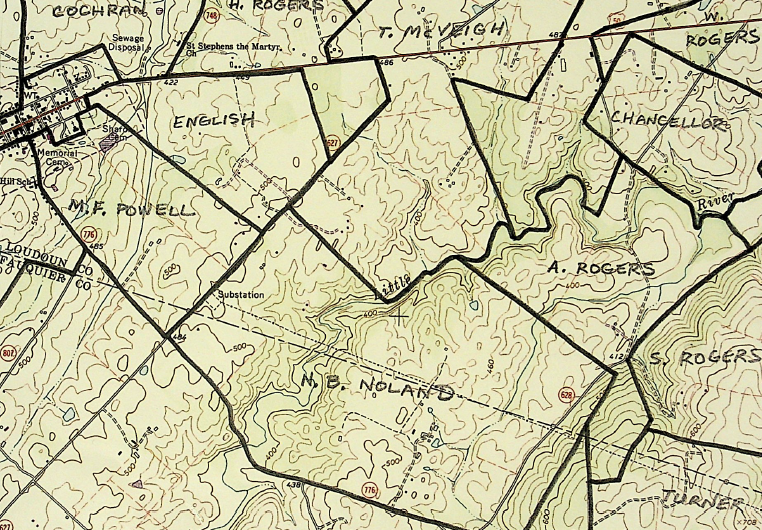
Map of Middleburg.
Now, to Stonyhurst (originally Mount Olive), an iconic stone manor house built in Edward Samuel Duffey (1841-1926) lived here after serving as a Confederate soldier in the 1861-1865 Civil War. When war was declared on April 12, 1861, he enlisted at the age of 19, fought in several battles, including on local fields at First and Second Manassas (July 21, 1861 and Aug. 28-30, 1862, respectively). Reportedly, he fired the last shot at the Battle of Gettysburg on July 3, 1863. According to Jim Burgess, museum specialist at Manassas National Battlefield Park, having been born and raised in Alexandria, Duffey enlisted in Captain Delaware Kemper’s battery (Alexandria Light Artillery) on April 17, 1861, the day Virginia seceded from the Union. Kemper’s battery participated in the First Battle of Manassas and Duffey can take credit for firing some of the last shots of First Manassas in the direction of the Cub Run Bridge (just below Bull Run). Burgess confirmed that he also fought at Gettysburg where his battery reportedly fired 800 rounds on July 3 and was among the last batteries to leave the field after Pickett’s charge was repulsed.
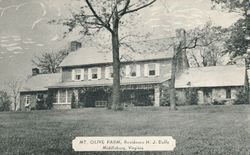
Above: Old postcard from the 1930s-40s of Mt. Olive (now Stonyhurst).
An August 13, 2016 post in Crossroads and Crossfire, a blog about the Civil War, includes a newspaper clipping of an article titled, “Soldier Who Fired the Last Shot At Gettysburg Tells His Story.” In the article, Duffey refers to Pickett’s charge: “… it was after Pickett’s charge. Gen. [Robert E.] Lee and Gen. [James] Longstreet were standing together under a tree in the old peach orchard at Gettysburg, when I came out with my gun and seven men. (I was an Artillery sergeant with Parker’s battery.) It was about 7 o’clock on the evening of July 3, 1863. Gen. Lee said something to Longstreet, and the latter came up to me and said, ‘Sergeant, have you any ammunition left?’ I replied that I had a little canister. ‘Very well,’ said Longstreet, ‘elevate your gun and give it to those Yanks coming up the road.’
“‘And that shot of mine was the last one fired at Gettysburg,’ he continued, still chuckling. Mr. Duffey has in his possession a letter endorsed by James Longstreet, which states that the incident happened as it was related here, and that his was indeed the last gun fired on the famous battlefield.”
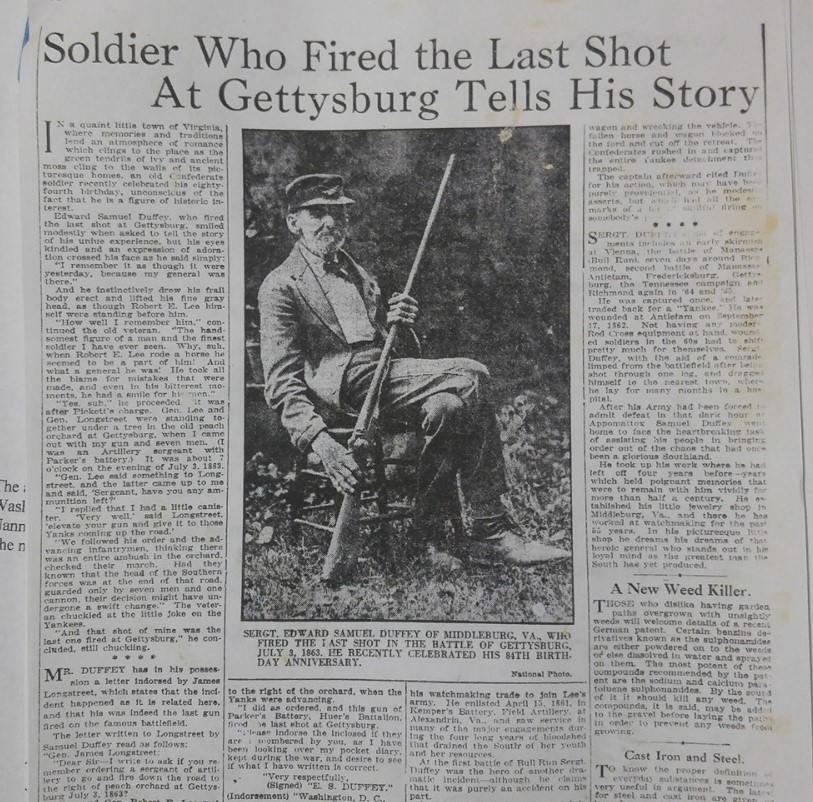
Edward Samuel Duffey (1841-1926) fired last shot at Gettysburg; in this 1925 photo, he was 84 years old. He lived at Stonyhurst (originally called Mount Olive).
After Lee surrendered to Grant on April 9, 1865 at Appomattox Court House, Duffey returned home and established his jewelry and watchmaking shop in Middleburg. On March 8, 1869, he married Loudoun County-born Amanda Muir Smith Duffey (1842-1926). One of their sons, Harry Johnston Duffey, Sr. (1871-1964), acquired Mount Olive. He served on the Board of Directors for the 1924-established Middleburg National Bank at 1 E. Washington Street, currently the home of King Street Oyster Bar. On November 1, 1899, he married Alice “Lalla” Pagaud Hawkins Duffey (1880-1965) in Charlottesville.
Regarding H. J. Duffey, Sr.’s equestrian legacy, he is listed as a founding member of The Middleburg Hunt, which dates as an organization to 1906. Just down the street from the Duffey property is Glenwood Park, home of Virginia’s oldest continuously running steeplechase since 1911. Middleburg Spring Races, the premiere steeplechase horse race held at Glenwood Park, has evolved into an annual world-class race event. Traditionally held in April, it has been rescheduled to June 13 of this year due to the coronavirus pandemic.
Stonyhurst remained in the Duffey family until the 1970s. The current owners acquired the 94.36-acre property in the early 2000s, and in 2005, invested in landscape designs and major renovations, returning it to its original glory with several improved amenities that have garnered two awards from the American Institute of Architecture. This revived manor house is centered on a large parcel of rolling land minutes from downtown Middleburg.
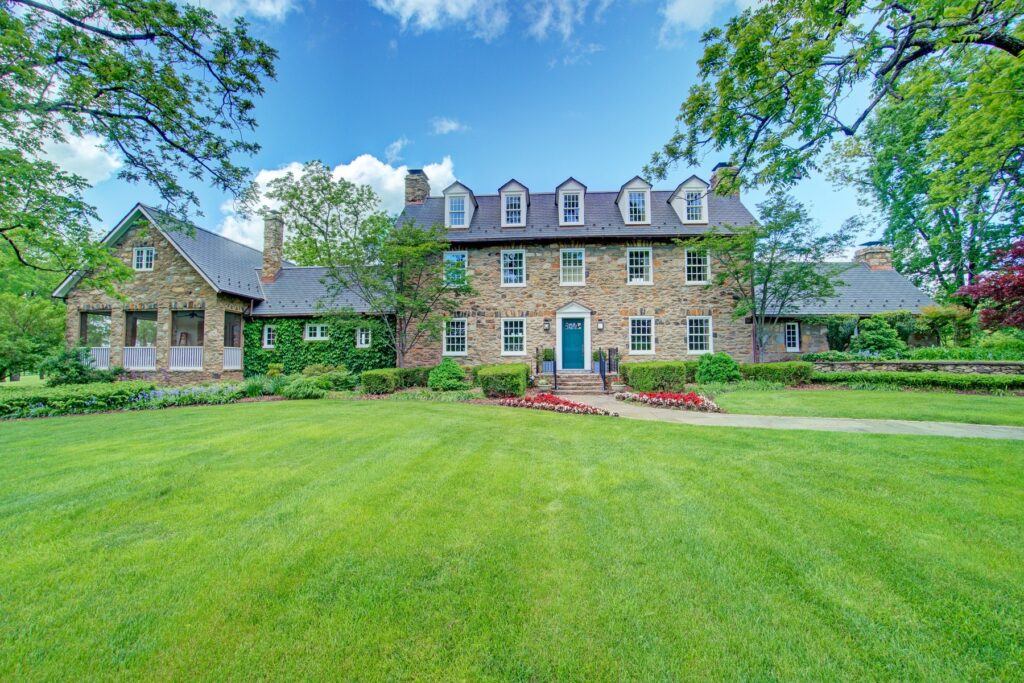
Historic Stonyhurst estate on Foxcroft Road.
Leonard-Morgan added: “The current owners of Stonyhurst had a vision of restoring the historic property, ensuring it wouldn’t be destroyed. They created an amazing revitalization of this old 19th century hunt country estate; it’s become this impeccable property.” To protect it from future development, they placed it under conservation easement. From the Powells to the Duffeys, both properties leave their mark for new owners to forge their own legacies. ML
For more information on these two properties, visit Sotheby’s International Realty at 2 W. Washington Street, Middleburg; call 540-687-8500 or visit sothebysrealty.com.
This article first appeared in the June 2020 issue of Middleburg Life.




